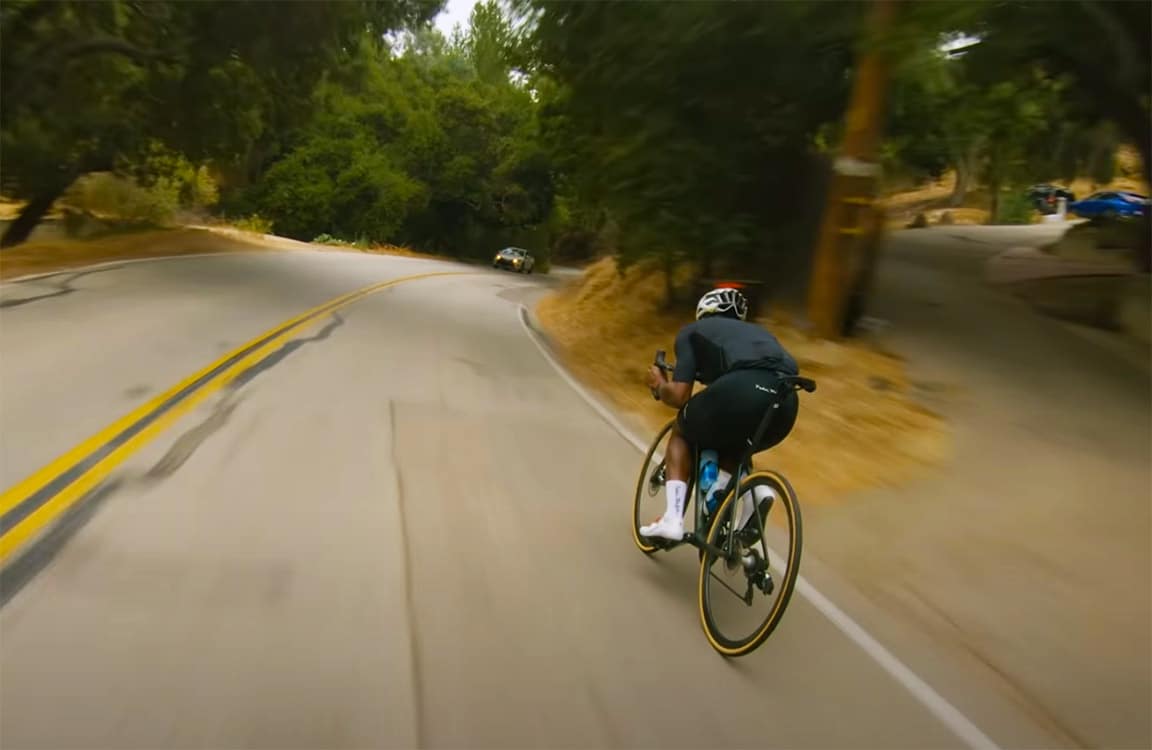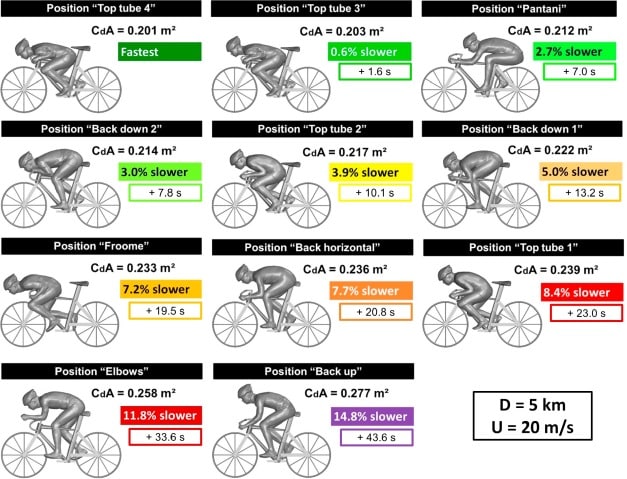
Why Banning the ‘Supertuck’ Descending Position is Futile
By Chris Carmichael,
Founder and Head Coach of CTS
So, cycling’s governing body, the Union Cycliste Internationale (UCI), has decided to enforce a ban on the ‘supertuck’ cycling position in the pro peloton because they say it is dangerous for the rider and riders nearby. I’m not as involved with pro cycling as I used to, so maybe I’m missing something, but pro cyclists crashing due to the ‘supertuck’ position doesn’t seem to be a notably frequent occurrence. Riders hitting ‘road furniture’ or crashing from poorly designed courses and poorly placed barriers? That happens way too frequently. Riders hitting or being hit by motos or support vehicles? That seems to happen way too frequently, too. But sure, ban the ‘supertuck’ and keep monitoring sock height.
Comment sections on social media and cycling websites suggest the supertuck was banned so the pros don’t set a bad example for amateur cyclists. If there were even a shred of truth in that it would be like making NASCAR drivers stop drafting so they don’t encourage tailgating on the highway. Professional athletes have better skills than normal people, and they are competing in a (theoretically) more controlled environment than amateur athletes. (Plus, there are Youtube channels dedicated to descending videos – including the ‘supertuck’ – that have millions of views…) There are a lot of things pro cyclists do on the bike that you shouldn’t do. Hell, there are a lot of things I used to do on a bike as a pro that I don’t have the agility, stability, or risk tolerance to do anymore.
For amateur cyclists I view the ‘supertuck’ descending position much the same way I view ‘marginal gains’. For most athletes, there is still plenty of room for improvement in fundamental training and handling skills, so you’re more likely to increase downhill speed more through learning to brake and corner better than by squeezing yourself onto your top tube.
That reminds me of a conversation with AMA Motorcycle Hall of Fame racer Miguel Duhamel, who said during his career he rarely, if ever, rode a motorcycle on the street. His focus was on racing motorcycles, which meant riding bikes with very specific technical setups, designed to go fast on closed tracks with safety equipment. Not only was riding on streets not as fun, but he perceived it as way too risky because of the massive differences in equipment (which necessitated different riding styles), the different surface conditions, and dangers like light poles and mailboxes that made the penalty for failure extremely high. Most of all, though, he didn’t want to ride a motorcycle in traffic with other vehicles and motorcycles – because of their skill and focus levels (or lack thereof).
Let the pros be pros. Even they know the difference between descending on a closed road in a race and bombing through the suburbs on a Tuesday.
Does the ‘Supertuck’ even matter?
When it comes to the ‘supertuck’ position in road cycling, which is defined as the rider crouched over the handlebars and sitting on the top tube, I struggle to see much of a benefit from banning it in the pro ranks. However, based on aerodynamics research from Blocken et al published in October 2018 in the Journal of Wind Engineering and Industrial Aerodynamics, I also don’t think banning the position will dramatically change race results.
The study examined 15 rider positions and the differences in aerodynamic drag and reduction in speed during a simulated 5-kilometer straight descent without pedaling. The “Froome position”, made famous from his descent of the Col du Peyresourde on Stage 8 of the 2018 Tour de France, looked extreme but turned out to be only the 7th most aerodynamic road bike positions (three time trial positions were also tested in the 15). The image below includes the road rider positions tested. The figure uses the fastest position, “Top tube 4”, going 20 meters/second for 5 kilometers as the reference, and then shows the percentage reduction in speed, and the resulting increase in elapsed time, for the slower positions.
In the aerodynamics study, three variations of ‘top tube’ positions were in the fastest six of 11 road examples. The “Pantani” position (chest on the saddle and butt behind the seat post) is an anomaly. It’s third fastest, but rarely used because… it’s insane. The last two of the top six fastest are ‘back down’ positions where the rider’s rear end is still on the saddle. These are still legal.
► Free Cycling Training Assessment Quiz
Take our free 2-minute quiz to discover how effective your training is and get recommendations for how you can improve.
Wind Tunnel vs. Real World
The ‘top tube’ positions are faster, but not by that much, especially considering that a 5-kilometer straight descent with no pedaling exists only in a wind tunnel or a computational model. The researchers openly recognize this in their discussion. That it’s not a realistic real-world scenario doesn’t invalidate the data. Those positions are faster… when you can use them. And that’s what closes the gap between the speed of a ‘top tube’ position and a ‘back down’ position.
In real life, cyclists don’t stay in any static position very long on a descent. So, let’s say you average 50kmh on a 5km downhill with curves and corners and varying steepness. It would take 6 minutes to get to the bottom, and out of the six minutes you might spend 10-30 seconds at a time in a ‘top tube’ position, and then have to get back up to brake, turn, pedal, and accelerate. It’s not that the time spent in a ‘top tube’ position won’t be lower drag, it’s that the advantage is whittled down by all the moving around to the point that banning ‘top tube’ positions isn’t such a terrible loss.
Is it necessary to ban the ‘supertuck’ for pros? Probably not. Will it make much of a difference in speed? Probably not. Will it make pro riders take fewer risks on descents? Absolutely not. And will it keep amateur riders from descending more aggressively than their skills can support? Not a bit.
References
Bert Blocken, Thijs van Druenen, Yasin Toparlar, Thomas Andrianne. “Aerodynamic analysis of different cyclist hill descent positions.” Journal of Wind Engineering and Industrial Aerodynamics, Volume 181, 2018, Pages 27-45.
https://doi.org/10.1016/j.jweia.2018.08.010.
► FREE Mini-Course: Learn How to Maximize Your Limited Training Time
Learn step-by-step how to overcome limited training time and get faster. Walk away with a personalized plan to increase your performance.


Comments 10
I just love this Chris. You make wonderful points and it just shows that those who govern bicycle racing are no longer or never have raced. I host a weekly podcast , radio show and Facebook page called Bicycle Talk and this new ubsurd rule has just made “Ron’s Rant of the Week”. Thanks for always staying involved and for what you contribute to our sport.
As a UCI Commissaire I struggle with being asked to enforce ludicrous rules and can assure you that my colleagues and I actually do spend much more time trying to improve safety through course and barrier design. As a motorbike Commissaire I can also assure you that we spend an increasing amount of time briefing moto riders about safety and trying to minimise the unintended draft they sometimes provide.
I have a different view on this – I think the ban is a good thing. As Chris points out, the ban is unlikely to change the outcome of a race. And it certainly won’t diminish my enjoyment of watching a race on TV.
And at the armature levels I think it will reduce pressure on racers to feel they have to use it to keep up on a downhill. I practice the supertuck and especially getting into and out of the tuck – on my trainer, at slower speeds, and at higher speeds on uncrowded roads. I feel “relatively” comfortable doing it but there’s no question it is not as safe. I have only rarely used it in races and only when trying to keep up with someone else who is using it. I don’t like it, but when someone in the tuck starts pulling away from you the “peer” pressure to use it is real. I look forward to not feeling like I need it to keep up.
Totally agree !!
Terrific article Chris. Cheers. Fire some reason government in any form seem to do the most ASININE things simply to maintain the illusion of their own necessity. I mean, sock height? Hahaha😲🤡😆
For 5 years I was a Sportive Ryder training with racers and ex racers and eventually did 3 races. I used to do the top tube tuck on occasion just to feel like a Pro. It IS a sketchy technique that I’m not inclined to even attempt today.
But people have to have some common sense. Everything looks ready when sometime else is doing it. I could watch the other Carmichael, Ricky the HoF motocrosss racer, leap across a70 foot triple jump on one leap, but even as a race winning Amateur, there no way in hell I would attempt something like that. A man MUST know his own limits is what I say.
Mr. Gump famously says “Stupid is as stupid does.”
Stay well
💪🏻😎🤗💪🏿
As you mentioned in the beginning, with so many other hazards and risks in racing such as the road furniture, motor bikes and team cars, the hazards of the super tuck seems ridiculous. The theme of a “solution in search of a problem” appears to be at play. Especially considering how much actual total time riders will be in said position during a racing stage of 3-4 plus hours. If safety is truly the concern, maybe they should ban the bunch sprints at the finish lines which cause much more carnage then the super tuck. Although, these all pale in comparison to the degree of risk posed by sock height, shoe color and kit pattern.
In my experience, I tried the super tuck on my older bike (06′ Giant TCR2) several years ago and never felt comfortable at all. Which surprised me because I always thought this bike was a very stable steady bike and I was always at ease with my hands off the bars to drink or eat. My new bike (17′ Cannondale Super SixEVO) has never provided the same sense of stability and I am much more reluctant taking my hands off the bars. But in the super tuck I am totally comfortable on the bike including the transition to and from. My impression is that the bike geometry and size may be factor in the safety and comfort of the rider.
If the UCI needs to ban something, perhaps it should ban the time trial bike. It no longer creates “marginal gains” because everyone has one, the riders cannot fully control their bikes (steering and braking are hazardous, and not as quick as on a regular bike), and there are far more serious accidents on time trial bikes, even among pros, than from the “super tuck”.
Go ahead. Flame away.
What a nonsense comment. Than you might as well put pros on grannie bikes, because they all have the lightest aero bikes anyways. Have you even ever ridden an TT bike??
Wow. “Nonense”? That’s sort of mean.
You know, the pros do NOT have the ‘lightest aero bikes’ — weight and aero features (such as tube profile ratios) are tightly controlled, and all the bikes could be lighter and more aero.
When it comes to multi-stage races, the OP has a valid point — make a single choice, and race it. What’s wrong with that?
Seems silly to ban, supertuck with hands in the drops probably just as safe as back down hands on the tops, either will take a change if you need real control quickly and they are pros